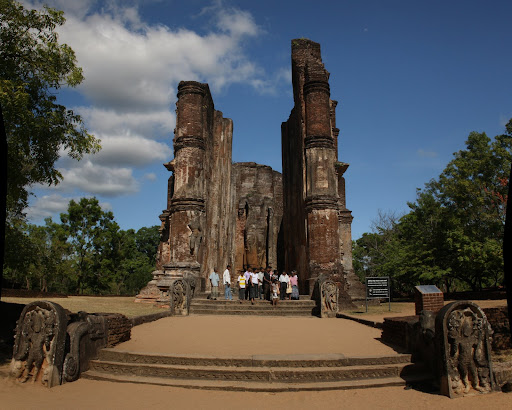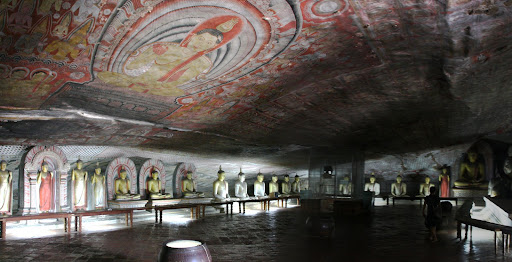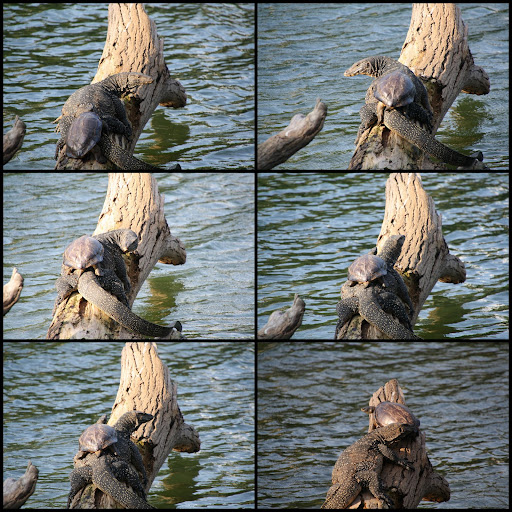The next stop for us in Sri Lanka’s Cultural Triangle was the ancient city of Polonnaruwa. We burned most of a morning on the journey from Sigiriya which involved two of those lovely red public buses. By the time we arrived we were only in the mood to relax in our splurge for the week: a room with AC!
Being the ruins of an ancient city, the sites within Polonnaruwa are quite spread out. We rented bikes from our guesthouse the next morning and got off to an early start. The goal was the see most of the major sites before the sweltering heat took hold of the situation.
Riding a bike in Sri Lanka is a bit scary at first. Actually, being in any vehicle in Sri Lanka is a bit scary. The roads are quite narrow and everyone is trying to overtake each other in seemingly impossible situations. Oh, and throw in the odd elephant or tractor for time to time just for good measure. Riding on the bus I couldn’t help but admire how calm the drivers are through all of this. Nerves of steel.
We made a bee line for the remote northern group of ruins when we first entered the park area. When we made it to the first large dagoba, Rankot Vihara, around 7:30AM and we largely had the place to ourselves if you don’t count the monkeys. (Another golden rule of Sri Lanka: all temples have monkeys. Lots and lots of monkeys.) Rankot Vihara is Polonnaruwa’s largest dagoba and, in case you were wondering, the center is filled with dirt and bricks. All in all, quite spectacular considering it is almost 1000 years old!
The nearby Lankatilaka gedige (a type of temple) was also quite a sight. The ceiling had collapsed but the massive walls (17 meters, the book tells me) still stand in a mostly vertical way. The standing Buddha inside was appropriately massive.
Even further north we came to Gal Vihara, a nice collection of rock carvings that are widely regarded to be some of the finest in all of Sri Lanka. There is a large 14m reclining Buddha and a smaller standing Buddha. Both are covered in an unsightly metal roof (infested with monkeys, I might add) that makes photography a bit difficult.
By the time we arrived at the relatively minor attractions (Lotus Pond and Tivanka Image House) in the far north corner of the park we were drenched in sweat. The final stretch of road to these sights was uphill and the sun was getting to be quite high in the sky. We rode back south to an area where there were some drink stalls and I promptly downed a liter and a half of water.
The southern end of the park, including the ‘quadrangle’ were our final stop before lunch. These are the most compact area of ruins in the park and are including on just about any tour of Polonnaruwa. If we were to go back and do Polonnaruwa again, we probably would have come here first thing in the morning as it was very crowded when we visited. Nevertheless, we still enjoyed seeing some very impressive stone carvings (including a 9m long ola book made of stone) and buildings.
After a quick bite to eat at our favorite eatery in town (Darshana Hotel on the main drag) we visited the Archaeological Museum (air conditioned! mostly) to some very interesting models of what many of the ruined buildings used to look like. The museum also had some good narrative in English but photos weren’t allowed.
From the museum we rode along Topa Wewa, the large tank (recall: tank is the Sri Lankan term for artificial lake) that sits west of Polonnaruwa. There is a nice road along the levy and the views of the surrounding countryside are quite picturesque, even in the blaring midday heat. A few kilometers down the lake we arrived at Polonnaruwa’s southern group of ruins. These are much smaller than the ones we saw further to the north and the highlight for us was a 4m-high stone carving of a person. Some believe it is one of the ancient kings.
By the time we finished with the southern group it must have been three or four in the afternoon and we were wiped out. The bikes were definitely a good choice but the heat made it very tiring despite the modest distances covered. The ruins of Polonnaruwa were definitely one of the stand-out attractions of Sri Lanka as were the country’s wild elephants. More on them in the next post.








